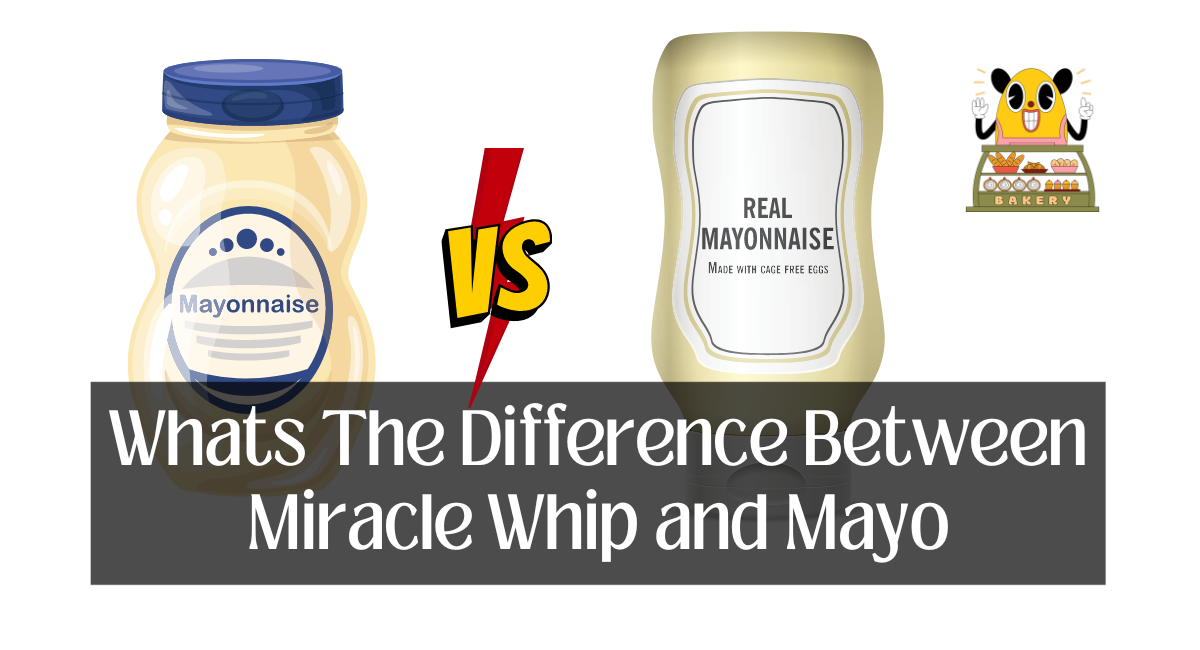Miracle Whip and mayonnaise are both renowned condiments with distinct qualities. Miracle Whip by Kraft Heinz is piquant and creamy, whereas mayonnaise is a traditional condiment with a rich, neutral flavor. Their ingredient composition, taste, and diverse culinary applications set them apart. This article, will explain what is the difference between miracle whip and mayo.
What Is Miracle Whip?
Miracle Whip, owned by Kraft Heinz, is a creamy condiment with a distinctive flavor. It contains water, soybean oil, vinegar, sugar, and spices, resulting in a sweeter and tangier taste than traditional mayonnaise. It is frequently employed as a condiment, dressing, or ingredient in various dishes.
What Is Mayo?
Mayonnaise, or mayo, is a traditional oil and egg yolk condiment. It is a versatile base for sauces, dressings, and spreads due to its rich, creamy consistency and neutral flavor. It is commonly used to add flavor and moisture to sandwiches, salads, and other dishes.
The Difference Between Miracle Whip And Mayo
1. Ingredients
Miracle Whip
As previously stated, Miracle Whip comprises water, soybean oil, vinegar, sugar, modified food starch, eggs, and various seasonings. The presence of water and modified dietary starch gives this mayonnaise a creamier texture than traditional mayonnaise.
Mayo
Mayo is mostly made up of oil and egg yolks. For flavoring and emulsification, a neutral oil, such as soybean or canola oil, is commonly blended with egg yolks, vinegar, lemon juice, and mustard. The simplicity of its elements accounts for the unique richness of classic mayonnaise.
2. Texture And Flavor
Miracle Whip
Miracle Whip is well-known for its tart and mildly sweet taste. Adding sugar and seasonings gives it a flavor that distinguishes it from mayonnaise. It is easier to distribute due to its creamier consistency.
Mayo
Traditional mayo has a thick, creamy consistency and a milder flavor. Its flavor is derived predominantly from the combination of oil and egg yolks and has a velvety texture.
3. Usage
Miracle Whip
Miracle Whip’s piquant and sweet flavor suits those who prefer dishes with a more pronounced flavor. It is frequently used as a salad condiment (especially for cole slaw), in sandwiches, and as an ingredient in dips and sauces.
Mayo
Mayonnaise is a versatile ingredient that forms the basis of many condiments and dressings, including tartar sauce and aioli. It is also commonly used as a binder in dishes such as potato salad and deviled eggs.
4. Cultural And Regional Variation
Miracle Whip
Miracle Whip is closely associated with the cuisine of North America, particularly the United States. Due to its distinctive flavor profile, it is frequently used in this region as an alternative to traditional mayonnaise.
Mayo
Mayonnaise is a condiment with recipes and ingredients that vary depending on culture. Mayonnaise is a staple in European cuisine and is frequently used in French fries and seafood dishes.
5. Preference
The preference of individuals for Miracle Whip or mayonnaise is highly subjective. Some people may prefer Miracle Whip’s piquant and slightly sweet flavor, whereas others may prefer traditional mayonnaise’s more prosperous and neutral taste. It frequently comes down to individual preference and the intended application.
6. Miracle Whip Contains Fewer Calories And Fat
Miracle Whip contains fewer calories and cholesterol than mayonnaise.
The table below compares the nutrient content of 1 tablespoon (15 grams) of Miracle Whip and mayo.
| Original Miracle Whip | Mayo | |
| Calories | 50 | 94 |
| Fat | 5 grams | 10 grams |
| Protein | 0 grams | 0 grams |
| Carbs | 2 grams | 0 grams |
7. Which One Is More Healthy?
Miracle Whip has less fat and calories, but mayonnaise may be better for you because it is less processed.
You should seek out mayonnaise prepared with healthy oils, such as olive or avocado, rather than inflammatory seed oils, such as soybean, canola, or corn.
In general, mayonnaise prepared with healthy oils is superior to Miracle Whip. However, using these condiments in modest quantities should not pose a significant health risk.
8. Benefits
Miracle Whip
- Tangy Flavor: Miracle Whip is well-known for its tangy and faintly sweet taste. This flavor can lend a distinct and delicious element to various dishes.
- Creamy Texture: Compared to traditional mayonnaise, Miracle Whip’s formulation includes water and modified food starch, contributing to its creamier texture. This makes it simpler to slather on sandwiches, incorporate them into salads, and incorporate them into dips.
- Versatility: Miracle Whip can be utilized in an assortment of dishes and applications. It functions as a vinaigrette base, sandwich spread, and ingredient in pasta salads, coleslaw, and other side dishes.
- Reduced Fat Content: Depending on the variant of Miracle Whip you choose, it may be available in a reduced-fat or light variety. This may appeal to those attempting to reduce their calorie or fat intake.
- Distinctive Taste: Miracle Whip’s tanginess and sweetness can be particularly alluring to those who prefer condiments with a more robust flavor profile.
- Convenience: Miracle Whip is packaged in a jar or squeeze dispenser, making it simple to dispense and store.
- Alternative To Mayonnaise: Miracle Whip can substitute traditional mayonnaise in recipes for those who prefer a tangier taste. It can add a new dimension to dishes that would otherwise contain mayonnaise.
- Added Ingredients: Miracle Whip typically contains seasonings and other flavor-enhancing ingredients, contributing to its signature flavor and suitability for specific dishes.
- Popularity in Certain Recipes: Some recipes specifically call for Miracle Whip due to its distinct flavor profile. If a recipe calls for Miracle Whip, it can help you achieve the desired flavor and texture.
Mayo
- Rich Flavor And Creamy Texture: Mayonnaise has a flavorful and creamy texture that enhances the sensation of foods. Its flavor is derived from the combination of oil and egg yolks, which provides a neutral, savory flavor that complements a variety of ingredients.
- Versatility: Mayonnaise is a highly versatile condiment that can be the foundation for various sauces, dressings, and dips. It is essential in classic dishes such as sauerkraut, potato salad, and deviled eggs.
- Binder And Emulsifier: Mayonnaise functions as a binder and emulsifier in recipes, bringing together ingredients that would otherwise separate. It is, therefore, beneficial for binding salad ingredients, forming meat patties, and stabilizing sauces.
- Base For Sauces And Dressings: Mayonnaise is the foundation for numerous famous sauces and dressings, including aioli, ranch dressing, Thousand Island dressing, and tartar sauce. Its neutral flavor allows for adding various herbs, seasonings, and flavors.
- Moisture And Flavor Enhancement: Mayonnaise can bring moisture and flavor to foods such as burgers and sandwiches. It prevents dehydration and enhances the overall flavor experience.
- Condiment For Sandwiches And Wraps: Mayonnaise is the traditional condiment for smearing on bread in sandwiches and wraps. Its velvety texture and neutral flavor complement numerous fillings.
- Ease Of Use: Mayonnaise is readily available in stores and numerous varieties, including conventional, light, and olive oil-based varieties. It is simple to use and store because of its practical packaging options, such as squeeze vials.
- Homemade Options: Many people appreciate making their mayonnaise at home because it allows them to customize the flavors, oils, and ingredients. It is possible to make homemade mayonnaise without preservatives and additives.
- High Fat Content: Although a high-fat content may not be preferable for everyone, it can benefit those on high-fat or low-carbohydrate diets. Mayonnaise’s fat provides satiety and contributes to a sense of fullness.
- Use In Baking: Mayonnaise can add moisture and tenderness to cakes and baked products when baking. It can supplant a portion of the fat in specific recipes.
- Gluten-Free And Dairy-Free Option: Option that is Gluten-Free and Dairy-Free Traditional mayonnaise is typically gluten-free and dairy-free, making it suitable for those with dietary restrictions.
Thanks for reading.

